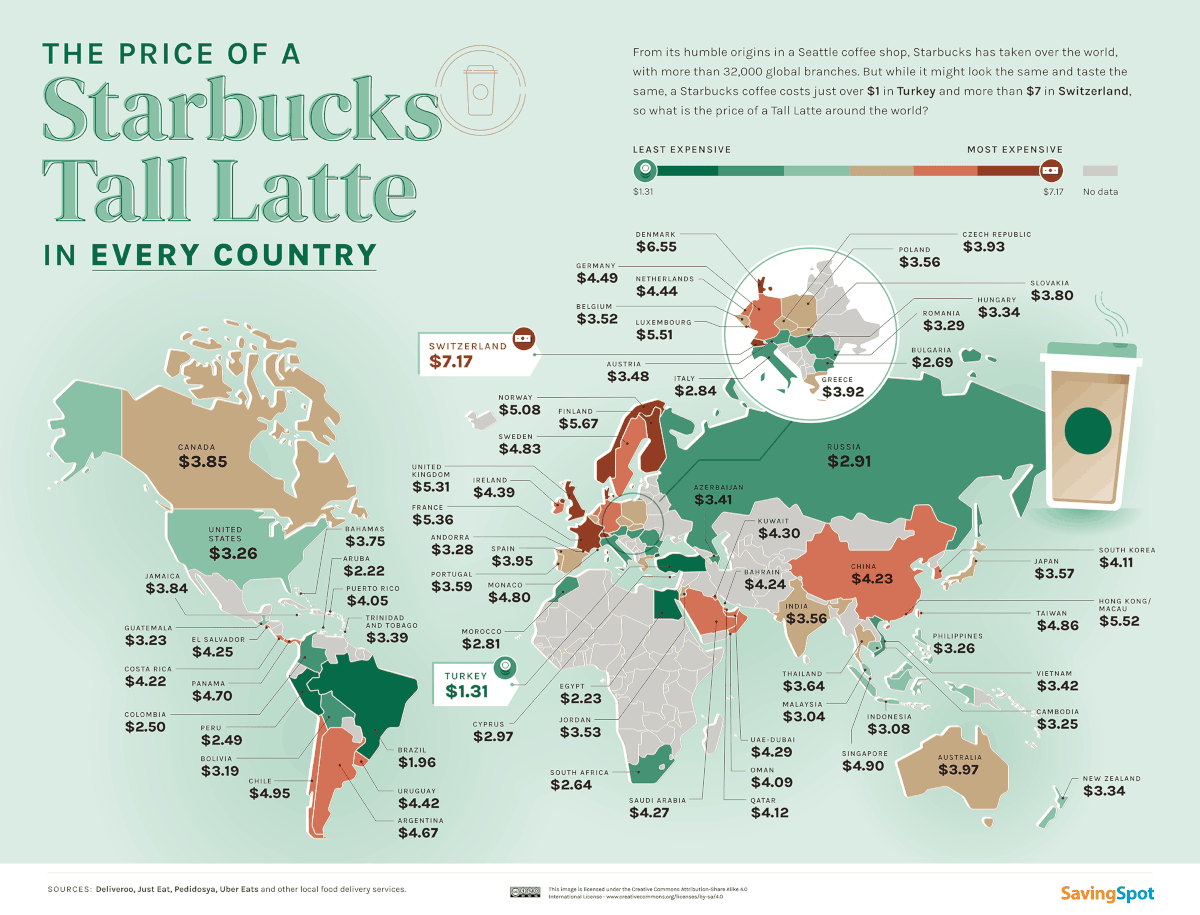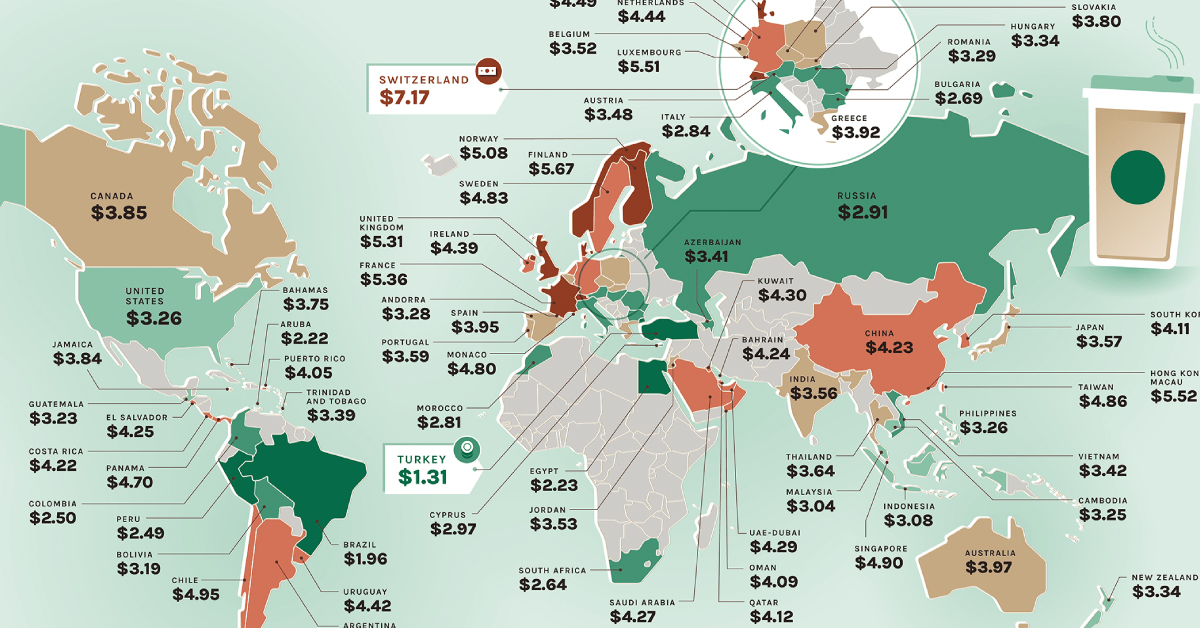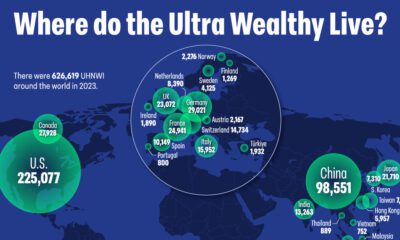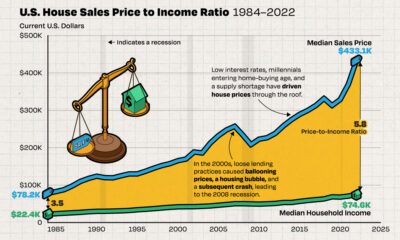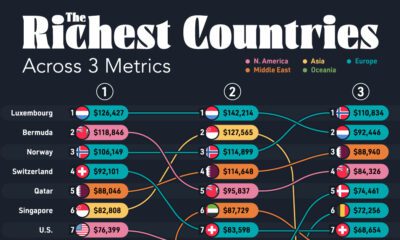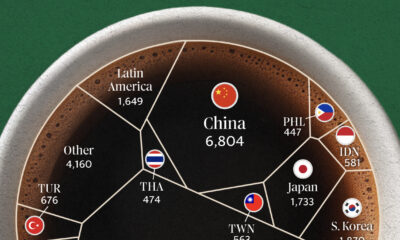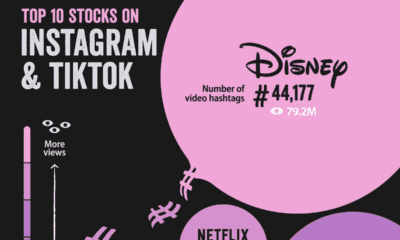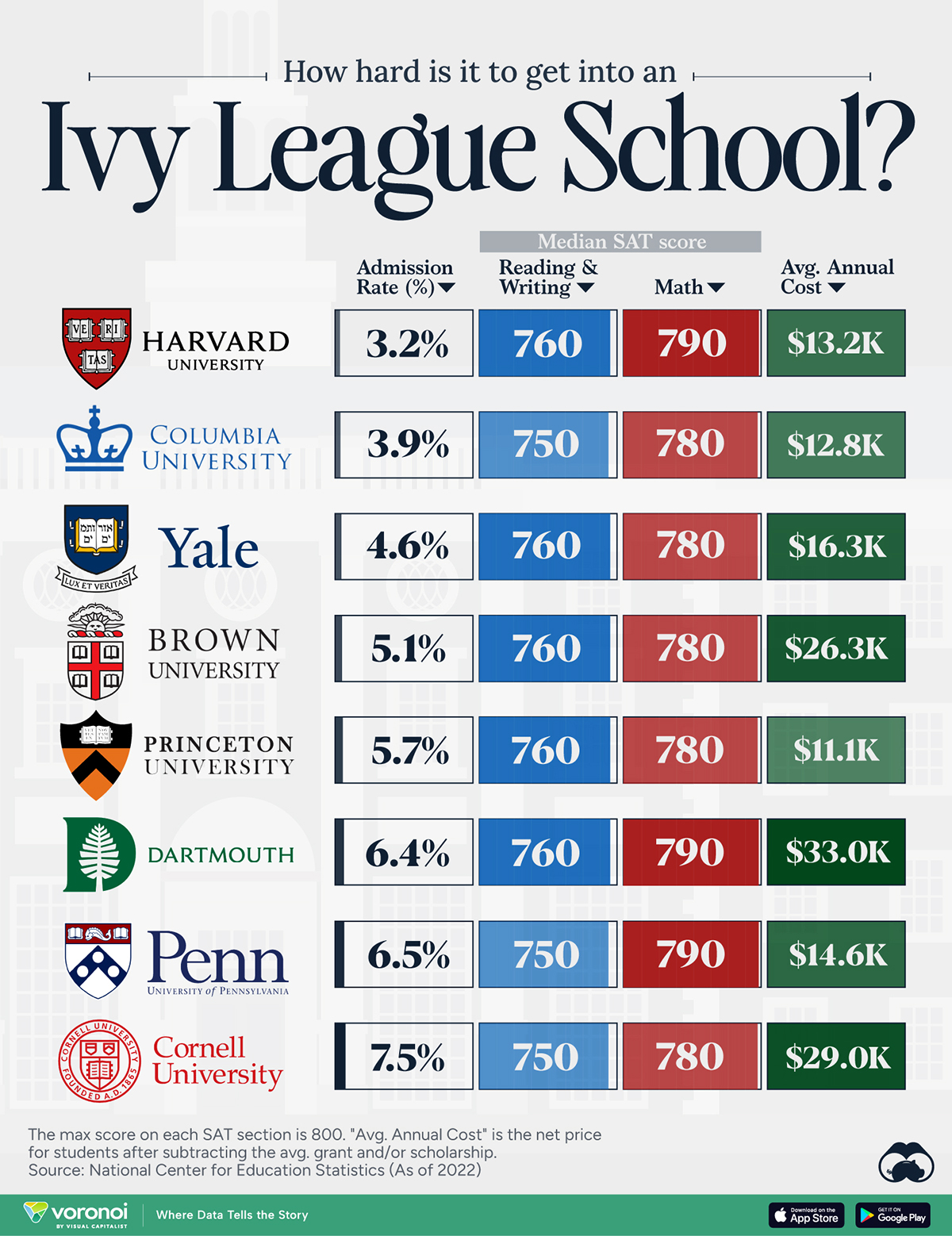Misc
Mapped: The Price of Starbucks Coffee, by Country
Click to view this graphic in a higher-resolution.
Mapped: The Price of Starbucks by Country
In 1971, three former students from the University of San Francisco set up the first Starbucks at Seattle’s Pike Place Market, selling fresh roasted coffee beans, teas, and spices from around the world. This was a relatively humble beginning for what is now the largest coffeehouse chain in the world.
Today, Starbucks boasts 32,000 stores across 80 countries, second only to McDonald’s in the fast-food chain business. And like McDonald’s, the price of a coffee at Starbucks varies wildly depending on the country you’re in.
This map made by SavingSpot has the answer to which country has the most and least expensive Starbucks coffee, for those connoisseurs who want to get the most bang for their (Star)buck—or for those who want to examine relative cost and purchasing power.
Which Country Has the Most Expensive Starbucks Coffee?
The underlying data for this map uses a combination of sources, including delivery apps, Google Reviews, menu images, and desk research, all cross-checked to come up with the price of a Tall Latte per country (converted to USD).
Per their findings, the most expensive Tall Latte (12 oz) in the world can be found in Switzerland for $7.17. On the other hand, the same drink can be bought for a little over a dollar in Türkiye.
Here’s the full rankings of the “Tall Latte Index”:
| Country | Tall Latte Price |
|---|---|
| Türkiye | $1.31 |
| Brazil | $1.96 |
| Aruba | $2.22 |
| Egypt | $2.23 |
| Peru | $2.49 |
| Colombia | $2.50 |
| South Africa | $2.64 |
| Bulgaria | $2.69 |
| Morocco | $2.81 |
| Italy | $2.84 |
| Russia | $2.91 |
| Cyprus | $2.97 |
| Malaysia | $3.04 |
| Indonesia | $3.08 |
| Bolivia | $3.19 |
| Guatemala | $3.23 |
| Cambodia | $3.25 |
| Philippines | $3.26 |
| United States | $3.26 |
| Andorra | $3.28 |
| Romania | $3.29 |
| Hungary | $3.34 |
| New Zealand | $3.34 |
| Trinidad and Tobago | $3.39 |
| Azerbaijan | $3.41 |
| Vietnam | $3.42 |
| Austria | $3.48 |
| Belgium | $3.52 |
| Jordan | $3.53 |
| India | $3.56 |
| Poland | $3.56 |
| Japan | $3.57 |
| Portugal | $3.59 |
| Thailand | $3.64 |
| Bahamas | $3.75 |
| Slovakia | $3.80 |
| Jamaica | $3.84 |
| Canada | $3.85 |
| Greece | $3.92 |
| Czech Republic | $3.93 |
| Spain | $3.95 |
| Australia | $3.97 |
| Puerto Rico | $4.05 |
| Oman | $4.09 |
| South Korea | $4.11 |
| Qatar | $4.12 |
| Costa Rica | $4.22 |
| China | $4.23 |
| Bahrain | $4.24 |
| El Salvador | $4.25 |
| Saudi Arabia | $4.27 (Iced Caffè Latte) |
| UAE-Dubai | $4.29 |
| Kuwait | $4.30 |
| Ireland | $4.39 |
| Uruguay | $4.42 |
| Netherlands | $4.44 |
| Germany | $4.49 |
| Argentina | $4.67 |
| Panama | $4.70 |
| Monaco | $4.80 |
| Sweden | $4.83 |
| Taiwan | $4.86 |
| Singapore | $4.90 |
| Chile | $4.95 |
| Norway | $5.08 |
| United Kingdom | $5.31 |
| France | $5.36 |
| Luxembourg | $5.51 |
| Hong Kong/Macau | $5.52 |
| Finland | $5.67 |
| Denmark | $6.55 |
| Switzerland | $7.17 |
The U.S. has the 21st-least expensive coffee in the world at $3.26 for a Tall Latte, making it an unusual combination of a high-income country with a low price. Usually, it’s more common to see countries with a “developing” or “low-to-middle income” status have cheaper Starbucks prices than higher-income countries.
The Price of a Tall Latte Relative to Income
However, simply converting local prices to USD doesn’t give the most accurate picture of how expensive Starbucks is in a country. Taking purchasing power into consideration, here’s how the price of a Tall Latte measures as a percentage of a country’s median daily income.
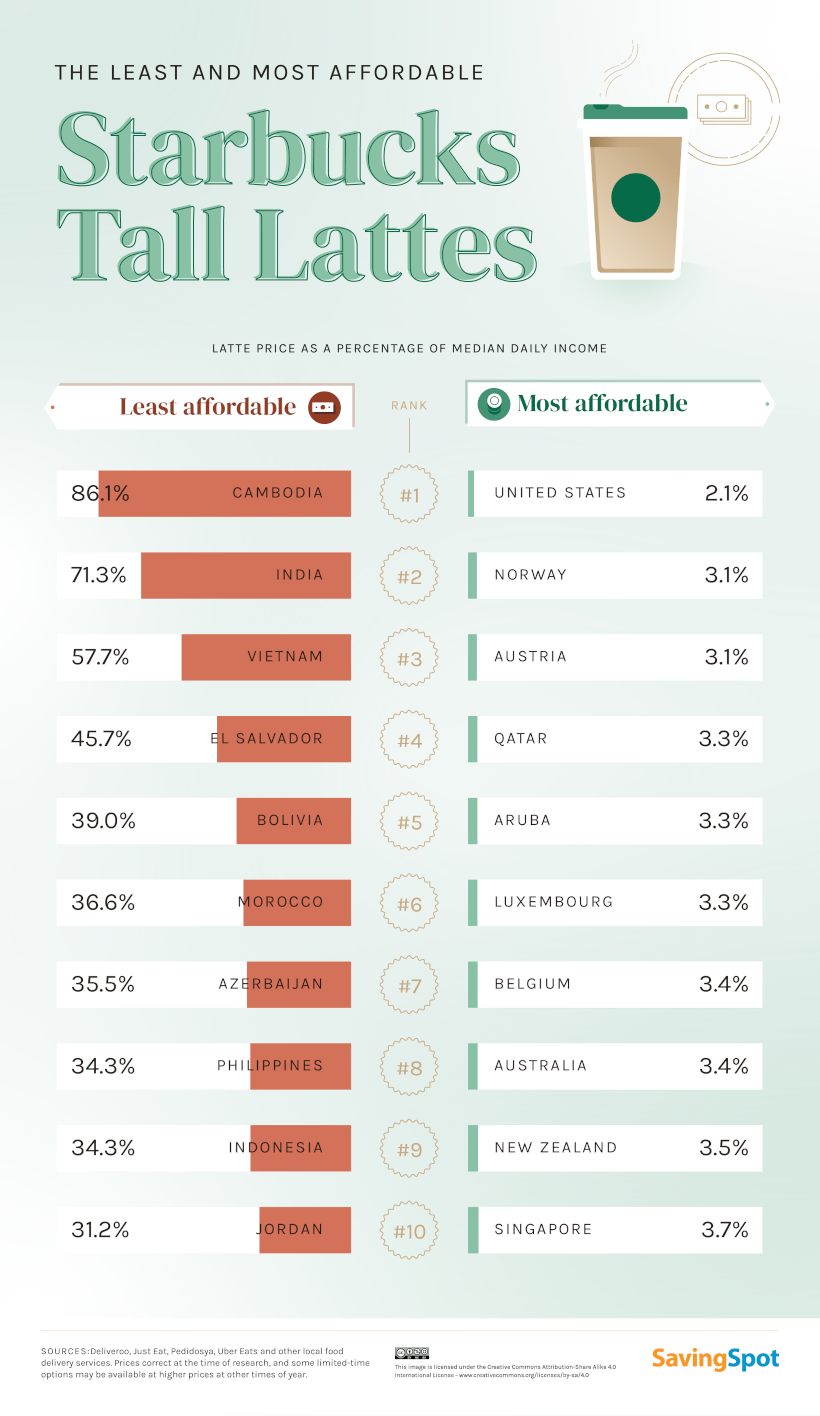
In Cambodia and India, it would take more than 70% of the median daily wage to buy a Starbucks coffee. Other countries with relatively cheaper Tall Lattes in U.S. dollar terms include Indonesia, Morocco, and Bolivia—but these are still not the most affordable for local customers.
For a more broad-based view of Starbucks affordability, SavingSpot has also charted the price of a Tall Latte against each country’s per capita GDP. Countries placing higher than the trendline get relatively bad value at Starbucks, while those below the line can get more lattes with their average local paycheck.
Switzerland, Denmark and Luxembourg all have expensive Tall Lattes, even relative to their high-earning populations.
But countries like Chile, Panama, and Argentina have the worst of both worlds. Not only do they have more expensive lattes than higher GDP per capita countries like Canada, the U.S., and Australia, they do so at a fraction of the income.
What’s the Most Expensive Starbucks Item?
Based on SavingSpot’s findings, the Iced Caramel Macchiato in Switzerland is the most expensive Starbucks menu item in the world, coming in at a whopping $9.31 for a coffee with vanilla-flavored syrup and a caramel drizzle.
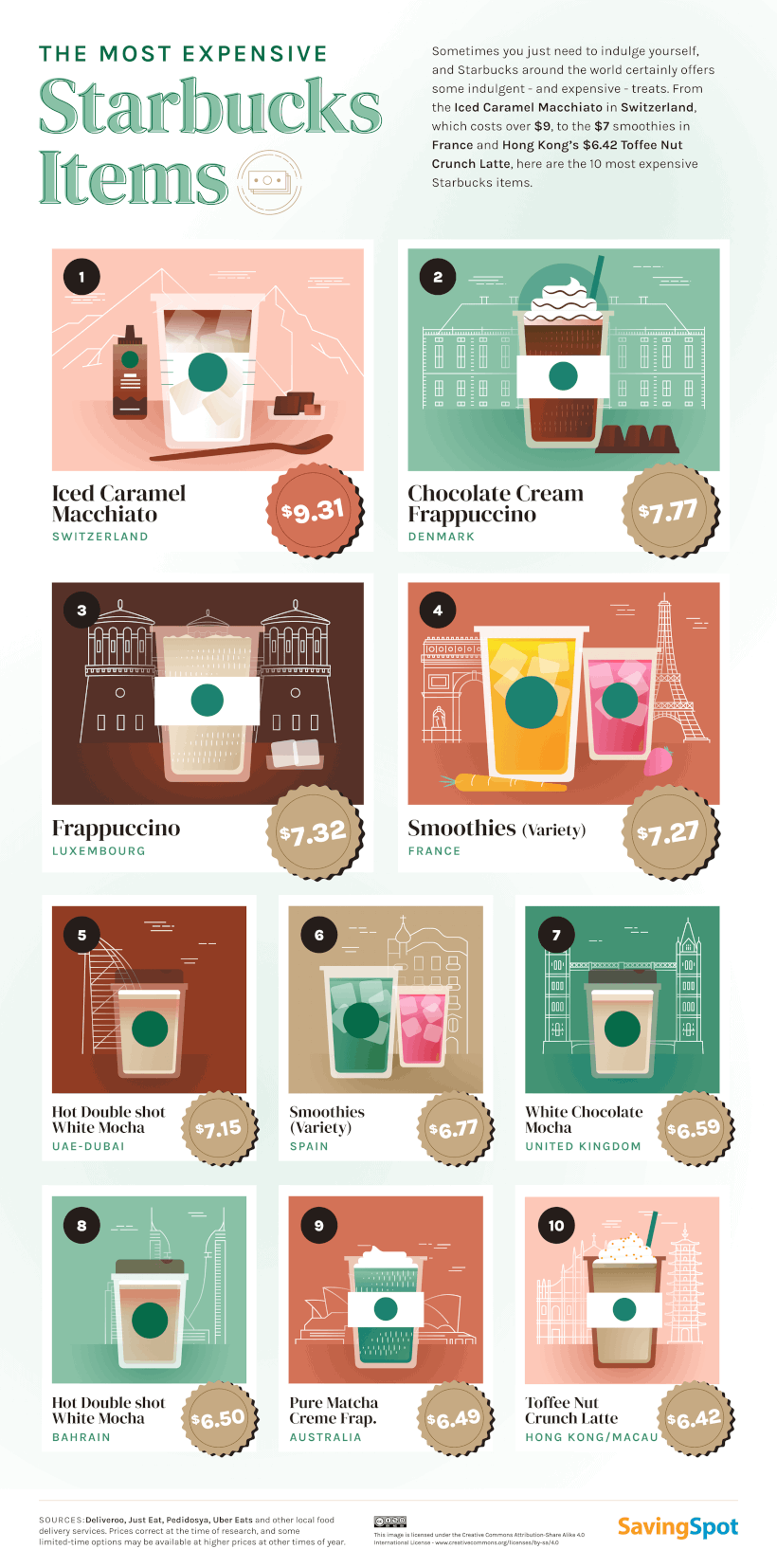
Denmark, Luxembourg, and France also have items well above the $7 USD price tag.
Whether those prices justify the quality of Starbucks coffee is a question best left up to the coffee aficionados, but for Starbucks, it’s a strategy that’s certainly helping the company’s earnings.

This article was published as a part of Visual Capitalist's Creator Program, which features data-driven visuals from some of our favorite Creators around the world.
Misc
How Hard Is It to Get Into an Ivy League School?
We detail the admission rates and average annual cost for Ivy League schools, as well as the median SAT scores required to be accepted.
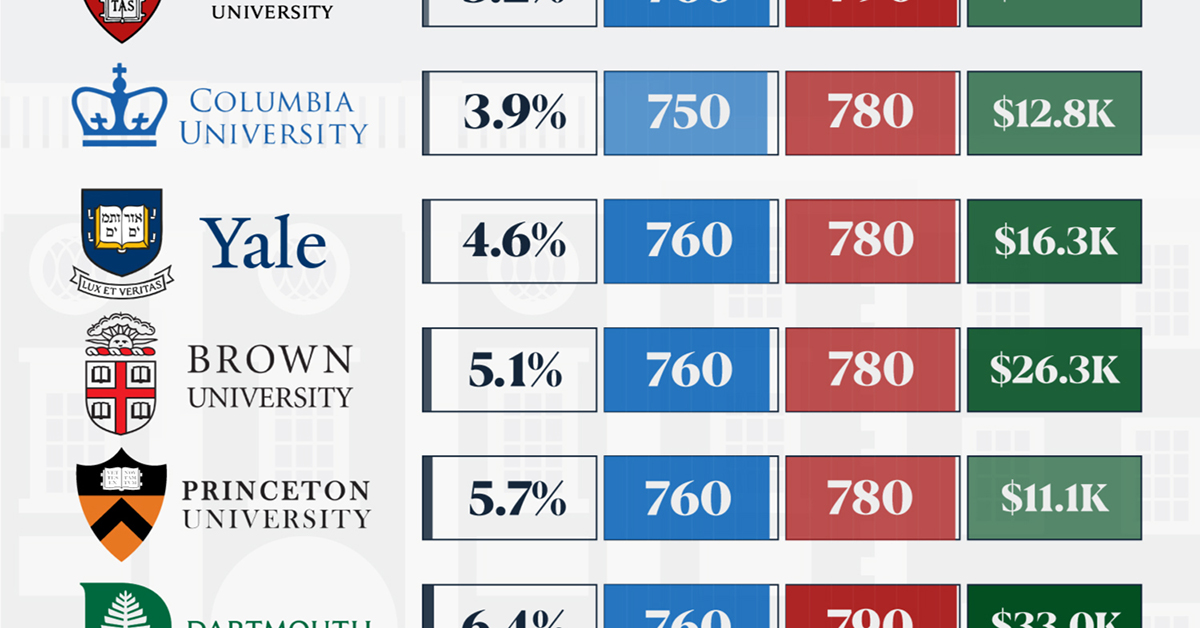
How Hard Is It to Get Into an Ivy League School?
This was originally posted on our Voronoi app. Download the app for free on iOS or Android and discover incredible data-driven charts from a variety of trusted sources.
Ivy League institutions are renowned worldwide for their academic excellence and long-standing traditions. But how hard is it to get into one of the top universities in the U.S.?
In this graphic, we detail the admission rates and average annual cost for Ivy League schools, as well as the median SAT scores required to be accepted. The data comes from the National Center for Education Statistics and was compiled by 24/7 Wall St.
Note that “average annual cost” represents the net price a student pays after subtracting the average value of grants and/or scholarships received.
Harvard is the Most Selective
The SAT is a standardized test commonly used for college admissions in the United States. It’s taken by high school juniors and seniors to assess their readiness for college-level academic work.
When comparing SAT scores, Harvard and Dartmouth are among the most challenging universities to gain admission to. The median SAT scores for their students are 760 for reading and writing and 790 for math. Still, Harvard has half the admission rate (3.2%) compared to Dartmouth (6.4%).
| School | Admission rate (%) | SAT Score: Reading & Writing | SAT Score: Math | Avg Annual Cost* |
|---|---|---|---|---|
| Harvard University | 3.2 | 760 | 790 | $13,259 |
| Columbia University | 3.9 | 750 | 780 | $12,836 |
| Yale University | 4.6 | 760 | 780 | $16,341 |
| Brown University | 5.1 | 760 | 780 | $26,308 |
| Princeton University | 5.7 | 760 | 780 | $11,080 |
| Dartmouth College | 6.4 | 760 | 790 | $33,023 |
| University of Pennsylvania | 6.5 | 750 | 790 | $14,851 |
| Cornell University | 7.5 | 750 | 780 | $29,011 |
*Costs after receiving federal financial aid.
Additionally, Dartmouth has the highest average annual cost at $33,000. Princeton has the lowest at $11,100.
While student debt has surged in the United States in recent years, hitting $1.73 trillion in 2023, the worth of obtaining a degree from any of the schools listed surpasses mere academics. This is evidenced by the substantial incomes earned by former students.
Harvard grads, for example, have the highest average starting salary in the country, at $91,700.
-

 Real Estate2 weeks ago
Real Estate2 weeks agoVisualizing America’s Shortage of Affordable Homes
-

 Technology1 week ago
Technology1 week agoRanked: Semiconductor Companies by Industry Revenue Share
-

 Money1 week ago
Money1 week agoWhich States Have the Highest Minimum Wage in America?
-

 Real Estate1 week ago
Real Estate1 week agoRanked: The Most Valuable Housing Markets in America
-

 Business2 weeks ago
Business2 weeks agoCharted: Big Four Market Share by S&P 500 Audits
-

 AI2 weeks ago
AI2 weeks agoThe Stock Performance of U.S. Chipmakers So Far in 2024
-

 Misc2 weeks ago
Misc2 weeks agoAlmost Every EV Stock is Down After Q1 2024
-

 Money2 weeks ago
Money2 weeks agoWhere Does One U.S. Tax Dollar Go?

